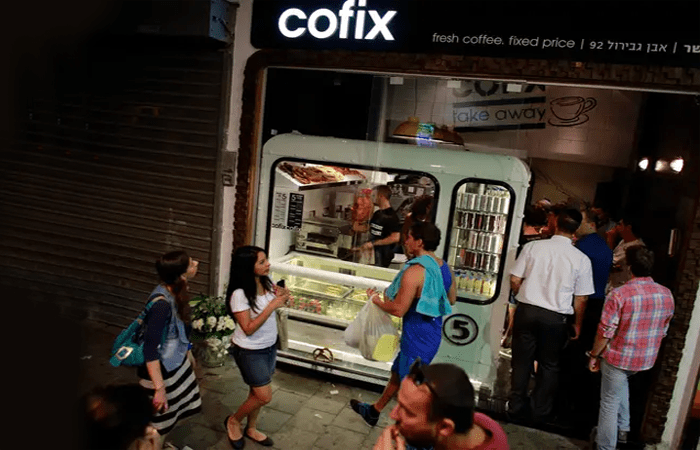What is Cofix’s recipe for success? Why has it captivated so many Israelis? Is it all about the price or has the company hit on something else?

“Cofix” is a new coffee chain that recently opened in Israel and sells a cup of coffee for 5 NIS [~US$1.50/€1], less than half the price at most coffee shops. What is Cofix’s recipe for success? Why has it captivated such a large audience? Is it all about the price or has the company hit on something else?
Until a few weeks ago, most of us believed that a cup of coffee was worth much more than 5 NIS. We would have reacted in disbelief to a price of 5 NIS and believed it was too good to be true, just like if we were offered a bottle of great wine for only a couple of dollars. The long lines outside Cofix, however, seem to demonstrate that it is offering more than just cheap coffee. Cofix has developed a new and successful formula to sell a known product.
To analyze Cofix’s success, we need to identify four principles that it successfully applied, whether methodically and consciously, or due to a strong intuition and retail experience. It is these principles that will allow other entrepreneurs to create value in a known business/service at a low price and to maintain that success over time.
1. Cut the level of service
This is exactly the opposite of the prevailing trend in recent years. Stores and retail chains have been adding services and products and offering customers a broad service package. This policy raises business costs, which are expressed in a product’s final price. Cofix got rid of additional costs, e.g., tables, waiters, the kitchen and floor space, leaving the cup of coffee to be drunk while standing and the option of limited varieties of sandwiches, pastries, soft drinks, etc. Cheap coffee was possible because of Cofix’s radically different business plan.
2. Product quality
If a product is inferior it won’t sell even a low price. In this case, the price is low but the product is not defective and there is no substantial drop in quality. In fact, many customers could not differentiate between different coffee brands in a blind taste-test. The average consumer is willing to receive a product of slightly lower quality in return for a significant price reduction.
3. Traffic (the importance of location)
A business with a low profit-margin needs higher than average customer traffic. This is the only possible way to compensate for very low pricing. A business operating at cost with low consumer traffic volume is not economically viable. The business must be located on a main street or a busy intersection or at a center of activity.
4. Shopping experience
The price is, of course, the main story, but not necessarily the main message. There are other examples of fast and cheap coffee stalls, whose aesthetics do not suggest the “world of coffee.” A low price is not a guarantee of success in the absence of correlation between location and product designs. Cofix invested in its look and justified its level of service. Cofix’s design supports its story – an express train car that has stopped for a moment, just like you, provides you with efficient service and then moves on to the next customer. The customer receives the story in the retail environment that slightly exceeds the product’s value – this creates a high compensation ratio for the consumer.
Maintaining the customer’s trust is immensely important and is the key to an inexpensive chain’s success. The customer wants to know that the product he receives has value, that he himself is not branded as being cheap or broke and that the low price is not a sign of disrespect for the customer or a lack of investment in the business. When a business like this succeeds in gaining a customer’s trust, the value ratio may cause customers at other chains to feel like they have been conned or fooled into paying high prices (a situation Israeli consumers cannot abide).
The range of coffee retail locations is very broad, just like in many other consumer categories. At the high-end, expensive coffee shops offer a quality product, uncompromising service and a rich customer experience. In contrast, at the low-end, there are coffee vending machines. Cofix is offering a product at the low-end’s price but with a much higher-quality product, which creates a kind of identity crisis for the mid-tier coffee shops, which must reinvent the experience and service they offer customers, or to reduce the price discrepancy.
A similar process can be applied in other retail fields, to offer a product or service that focuses on providing higher value than a vending machine. The Japanese market has vending machines that sell everything, from batteries to lingerie. Whatever can be sold by a machine can also be sold by a small business.